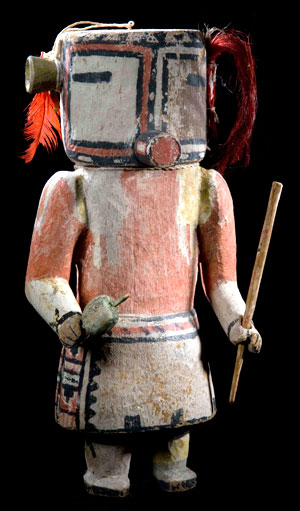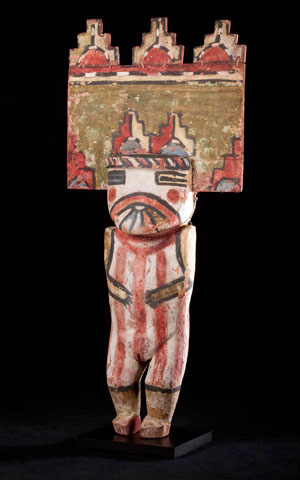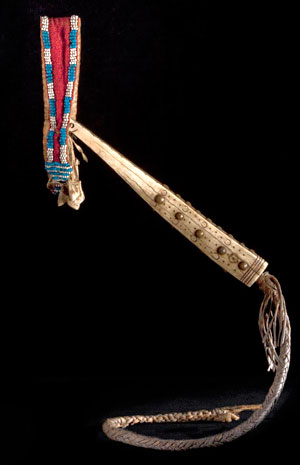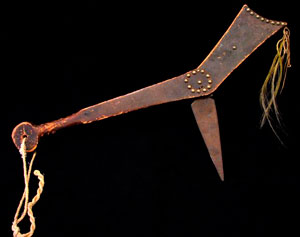|
SOME THOUGHTS ON COLLECTING INDIGENOUS ART
Europeans first started to collect exotic objects when Chinese porcelain was introduced in 1512. Psychologists believe that children naturally collect objects, whether shells, stones or blades of grass. The experience of collecting 'art' may be peculiar to the modern Western world, although argument might be made that the cave paintings in Europe constituted the first painting collections. Since there aren't any signs of long-term habitation in these caves, it's possible they were the first museums. (No admission fee!) Some make the argument that these cave paintings weren't collections at all, that they were, in fact, magical formulas meant to aid in the hunt, something akin to religion. Ah, but isn't that the point of all collecting – something magical that is akin to religion? Collectors love their collection. It is a source of pride as well as something to delight oneself. One of the great pleasures in being a dealer is visiting people and their collections. To the uninformed eye, almost any collection of almost anything merely looks like an accumulation. To the informed eye, however, once again the word 'delight' is applicable. Collectors are happy to showcase their collection, especially if one is happy to see it. What is the source of this joy, of this connection between someone and the objects they have placed together? "I think of this collection as a living being composed of objects which are all linked by the same creative spirit" (Mr. Rosenthal, quoted in the introduction of the catalogue for the sale of his Oceanic collection at Sotheby's Paris on March 24, 2010). Traditionally, psychologists have maintained that collecting filled a void that was related to childhood. I remember the story of Frank Sinatra visiting Alexander Gallery on Madison Ave in the mid-1980's to see the model railroad trains. Contemporary psychology, however, sees limitations in this theory. While the childhood-void thesis may apply to some, for the vast majority of collectors, the reasons are numerous and individual. What is paramount is that the collector connects emotionally with the material he or she is collecting. As Dr. James Meltzer, a psychologist and psychoanalyst as well as a life-long collector, has pointed out, these reasons are often complex and over-lapping. Suffice to say, there is the art and there is the human response to it. Indigenous art was not referred to as 'art' until fairly recently; it wasn't referred to as 'indigenous' until even more recently. No doubt, the term will continue to evolve. What we have seen is that the response of mainstream society to material goods made by indigenous peoples has mirrored the response of the society to the people who made it. For example, when the Europeans were colonizing the New World, the objects were known as 'artificial curiosities' to differentiate them from the 'natural curiosities', the flora and fauna of the colonized lands. Today we call these objects 'art' even though the people who made them, whether for utilitarian or ritual use, had no such word in their vocabulary. One reason we now call these objects 'art' is that the meaning of the word itself has changed. In the nineteenth century, the word 'art' meant something very specific – a painting with a fixed viewpoint created according to traditional perspective theorems. This well-ordered art-view, however, was blown away by the events and art of the 20th century. As William Barrett so eloquently pointed out in his landmark study IRRATIONAL MAN, the perspective of traditional art was flattened both in its point of view and its content by the modern approach. The fixed perspective no longer applied. Likewise, the old colonial attitudes would give way to modern realities in due course. It would still be quite some time, however, before the center of the traditional art world would apply the three-letter word to indigenous work. Perhaps television had to become integrated into society first. Marshall McLuhan was the first to point out the similarities in perception between pre-literate societies and the post-literate one. When he first talked about this, in the 1950's, television was the new media and he foresaw how it would change the perceptions of society as much as the printing press had done in the fifteenth century, not coincidentally shortly before European society began collecting Chinese porcelain. McLuhan believed that the new electronic culture would create a plugged-in society that would be instantaneous and global. In 1968, he wrote that in the new electronic age, "the industrial worker would be on a par with the savant" (1). Sounds like Google. He pointed out that the literary person reads in a linear progression; such a world, and its art, is more ordered and the perspective is fixed as opposed to an electronic culture where everything happens simultaneously. The world of the pre-literate man is also one where everything occurs simultaneously. McLuhan used sports to clarify his point. The literary culture developed baseball where each defensive player has a fixed position and each offensive player has a set pattern to achieve his goal – running around the bases to score a run. In soccer or basketball, however, the action occurs all across the field of play and it occurs simultaneously without any pre-set pattern. Interestingly, both basketball and soccer are played against the clock while the pre-electronic baseball game is played in a timeless setting. This is the counter-intuitive logic that proves the point. Carl Jung said that when modern man first acquired a timepiece, he lost contact with the eternal present, that moment, he said, that the man who is riding a camel across the desert always lives in. The affinity between the art of indigenous peoples and modern art has been long established. With William Rubin's landmark exhibition "PRIMITIVISM IN 20TH CENTURY ART" in 1984, it entered into the basic tenets of the world's most prestigious institution devoted to modern art. McLuhan didn't bother with such things. He was more concerned with the audience. Why would the people who responded to modern art also respond to indigenous art? For McLuhan, it was a matter of environment – both the indigenous artist and the modern artist lived in what he termed an audio-tactile world as opposed to the literate society that he said lived in a visual world. Simultaneous point-of-view versus fixed point-of-view. He said that the electronic culture totally surrounds us and connects us. He coined the phrase 'the global village'. One result of our inter-connectedness would be what he called the 're-tribalization' of society. One aspect of this re-tribalization has been the ethnic violence that has flared in the former Yugoslavia, in Chechnya, as well as Iraq, Afghanistan and areas of China. |
The rise of the tattoo culture over the last thirty years is another manifestation of re-tribalization. Tattoos were commonly used in indigenous cultures to connote class and status in society. Today the tattoo is often a statement in the post-modern age to separate oneself from the mainstream and a proclamation of one's individuality. Millions of people have chosen to proclaim their individuality this way. If you google 'tribal art', the response is pre-dominantly tattoo art. It's just another way to collect indigenous art – wear it on your skin!
For those who would rather hang it on the wall and perhaps re-sell it someday, or hand-it-down, there is the opportunity of the tribal art marketplace. This opportunity is still in its early stages – wait until the millions who are members of the tattoo culture begin to collect the art that hangs on walls or sits on pedestals. The burgeoning Green movement – a geo-political necessity at this point in human life – also relates well to re-tribalization. The indigenous person, for the most part, understood his place in the eco-system in a way that the conquering literary cultures did not. Manifest Destiny does not go hand-in-hand with re-cycling.
While we all collect for our own individual reasons, none is more important than the connection we feel with the material. This connection is both an outgrowth of our individual experience and our understanding. Our understanding is shaped by our perceptions. And our perceptions are informed by the world in which we live. The recognition of the intrinsic value of the finest indigenous art is still in its infancy. What society couldn't recognize as art before the advent of television has only really begun to be appreciated. In our own time and in our own ways, we can realize what our forefathers couldn't. This recognition is part of our legacy to the coming generations.
Copyright 2010 by John Molloy
1 – UNDERSTANDING MEDIA: THE EXTENSIONS OF MAN by Marshall McLuhan (McGraw-Hill; 1964. Chapter 4)
The author would like to gratefully acknowledge conversations with Drs. Paula Rubell and Abraham Rosman on the anthropology of collecting; with Dr. James Meltzer on the psychology of collecting; with Vanessa Elmore of Morningstar Gallery on the tattoo culture. This essay was originally published in a slightly different form in WHITEHAWK NEWSPAPER (August 2010)
For those who would rather hang it on the wall and perhaps re-sell it someday, or hand-it-down, there is the opportunity of the tribal art marketplace. This opportunity is still in its early stages – wait until the millions who are members of the tattoo culture begin to collect the art that hangs on walls or sits on pedestals. The burgeoning Green movement – a geo-political necessity at this point in human life – also relates well to re-tribalization. The indigenous person, for the most part, understood his place in the eco-system in a way that the conquering literary cultures did not. Manifest Destiny does not go hand-in-hand with re-cycling.
While we all collect for our own individual reasons, none is more important than the connection we feel with the material. This connection is both an outgrowth of our individual experience and our understanding. Our understanding is shaped by our perceptions. And our perceptions are informed by the world in which we live. The recognition of the intrinsic value of the finest indigenous art is still in its infancy. What society couldn't recognize as art before the advent of television has only really begun to be appreciated. In our own time and in our own ways, we can realize what our forefathers couldn't. This recognition is part of our legacy to the coming generations.
Copyright 2010 by John Molloy
1 – UNDERSTANDING MEDIA: THE EXTENSIONS OF MAN by Marshall McLuhan (McGraw-Hill; 1964. Chapter 4)
The author would like to gratefully acknowledge conversations with Drs. Paula Rubell and Abraham Rosman on the anthropology of collecting; with Dr. James Meltzer on the psychology of collecting; with Vanessa Elmore of Morningstar Gallery on the tattoo culture. This essay was originally published in a slightly different form in WHITEHAWK NEWSPAPER (August 2010)




